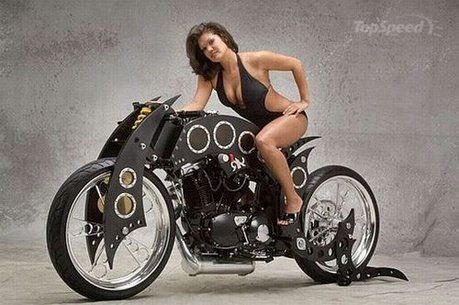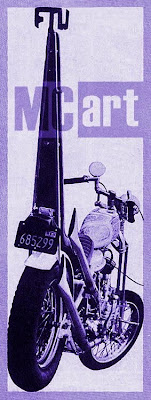Photos by Yves J. Hayat, Bernard Salvat and the Southsiders:
The 'story within a story' at the
Grande Peugeot Display at
Rétromobile was the assembly of rare, historic racing machines, and a few of their equally rare riders! Bernard Salvat (where is your Wikipedia entry,
monsieur?) did not bring together a typical 'old bike' hodgepodge show of Club machines from the local collectors; he curated a museum-worthy Exhibition which told the story of Peugeot from the dawn of the 20th Century to the present day, and yes, for our Yank readers,
Peugeot has been in continuous production since 1898, which I believe makes it the
oldest motorcycle manufacturer in the World? No?

Unfortunately for us English speakers, there is very little published information extant about the marque in our tongue; Salvat's
magnum opus 'Motos Peugeot' ('1898-1998, 100 ans d'histoire', written with Didier Ganneau, EBS, 1998), remains untranslated, and the prospects are grim as Peugeot hasn't sold a car or motorbike in the US for decades. So, I muddle through with my horrible French (sad, given my surname; my Gallic pals chide me no end), but like the readers of this website, I enjoy the photos thoroughly!

These top images depict a 1914 racer with the oversize 'Peugeot' logo in white, as mentioned in my previous post; this is a rare survivor of a one-year production race machine. Whether a test example or prototype or blind alley, the little 500cc Sidevalve v-twin represented the current thinking of the world's racing fraternity; the reliability and efficiency of a Sidevalve motor was a way to win races, and 'F-head' or troublesome 'OHV' machines had technical problems in 1914 which the SV did not.

This machine was saved from oblivion by a canny collector, who recognized the very large engine pulley, special cylinders, and twin-barrel Claudel carburetor as a clues to a very rare racer. It shares the cycle gear with the famous 'Paris-Nice' model, which include the clever leading-link front forks. While this 500cc twin may have represented 'state of the art' racing technology of 1914, as compared with the rest of the world, Peugeot had far greater ambitions, and dropped this racer after only a few events, in favor of their truly astounding Double Overhead Cam, 8-Valve parallel twins! (below)

The facts on the ground in 1914. In the race for the most technically advanced motorcycle on the planet, Indian led the pack, first away with their
'8-Valve' racing twin in 1912, which by 1914 had become a well-established world beater. In 1914, the
Cyclone appeared with their astounding Overhead Camshaft v-twin engine, truly the stuff of legends, as was the Indian. But of course, it was Peugeot in 1914 who trumped them both, by creating the first twin-cylinder Double Overhead Camshaft engine, the '500 M' parallel twin of 500cc, a technical tour de force which placed Peugeot as creators of the Most Advanced Motorcycle in the World for many years, until the Italians doubled the formula in 1928 with their O.P.R.A. 4-cylinder DOHC design (
which became the infamous Gilera 4 cyl. racers). And even this amazing machine of '28 had only two valves per cylinder!

Some history, as this machine didn't appear out of thin air. Ernest Henry studied engineering at the Technion in Geneva, and by 1906 was developing marine engines. Moving to Paris in 1901, he worked on both marine and aviation engines until 1911, when he joined Peugeot, to create their four-cylinder car engines
'L3' (3 liters) and 'L76' (7.6 liters), used in their
successful racing cars from 1912, which totally dominated GP racing that year (winning the GP de France,
Mont Ventoux, GP de
l'ACF - Automobile Club de France, etc). The engines Henry designed weren't the first '4-Valves per Cylinder' design, nor were they the first 'Double Overhead Camshaft' engine, but they were the first engine in the world to have all the above. To cap it all, the 'L76' had
Desmodromic valve operation! Decades ahead of the competition.

In 1913, Henry changed his camshaft drive from 'Shaft and Bevel' to 'Train of Gears', and these cars continued their winning streak at the
Indianapolis 500, the GPs of France, and at Brooklands. Our M 500 racing machine is a miniature version of this type of engine, halved to produce a parallel twin, using a train of gears between the cylinders, with a mechanical oil pump driven by the camshaft. Transmission was 'chain cum belt'; chain primary drive with clutch, but a single-speed gearbox with belt drive to the rear wheel.

The M 500 was first raced at the
Circuit de Rambouillet on April 5th 1914, on muddy roads, which factory rider Desvaux won, the only 500cc rider to finish the race! On June 14th, Paul Pean, a factory mechanic who raced their cars since 1907, entered the machine for a 'Records Day' organized by the A.C.F., in the forest of
Fontainebleau, which had a long straightaway along the county line. Pean broke two World Records in the 500cc class that day, 122.449km/h (73.47mph) for the Kilo, and 121.205km/h for the Mile. Then, the War...and Ernest Henry left Peugeot in 1915.

Post War, the dohc 500 survived and was raced again by Desvaux, with some success. In 1920, a 3-speed gearbox was added by engineer
Marcel Grémillon, but the setup proved troublesome, as did maintenance on the engine, due to the gear train between the cylinders - the engine had to be totally stripped down to do even minor running repairs. So in 1920, Grémillon drew up a revised engine, with new crankcases and the gear train up the side of the engine, keeping the DOHC and 8-Valves. This meant the end of the 'Henry' 500 M, and the original machine disappeared, and has never been seen again.
The machine in these photographs is a faithful reproduction of Henry's machine, which has been eleven years in the making, using the original blueprints.
Keep in mind also, that the very first Isle of Man TT winning Norton used a Peugeot engine!
See my previous post on the subject. Many thanks to Bernard Salvat for his research into these amazing motorcycles!
Many thanks to Bernard Salvat for his research into these amazing motorcycles!
 A friend on the Veteran Motorcycles Forum suggested a look at this fascinating home-built 'Planet' motorcycle; fully a 1500cc OHV from 1916! It is claimed the machine would do 85mph, which sound tremendous, given the poor state of the roads at that early date. Here is what the Melbourne Museum says about it's most interesting exhibit:
A friend on the Veteran Motorcycles Forum suggested a look at this fascinating home-built 'Planet' motorcycle; fully a 1500cc OHV from 1916! It is claimed the machine would do 85mph, which sound tremendous, given the poor state of the roads at that early date. Here is what the Melbourne Museum says about it's most interesting exhibit: worse for an afternoon at the local hostelery" according to his son Monty. John Oliver made the wooden pattern for the engine mouldings and castings were obtained from Chas Ruwolt's foundry in Victoria Street, Richmond and then machined on Oliver's own workshop lathe, including turning the cooling fins. The motor cycle has a large 1497 c.c. capacity V-twin cylinder engine and a single-speed transmission with a lever operated clutch. Originally it was capable of a top speed of 85 m.p.h (140 km/h). The original carburettor was a Zenith later replaced by a Schebler. The original wheels were replaced around 1938 with a pair of conventional second-hand motorcycle wheels. John Oliver died in 1949 and the Planet was left dismantled in storage. John Oliver's sons, Allen and John (Monty) Oliver decided to reassemble the machine around 1980. One replacement magneto was purchased and a non-original S.U carburettor was fitted at this time. After Allen's death, Monty Oliver donated the Planet to the Museum in 1987.
worse for an afternoon at the local hostelery" according to his son Monty. John Oliver made the wooden pattern for the engine mouldings and castings were obtained from Chas Ruwolt's foundry in Victoria Street, Richmond and then machined on Oliver's own workshop lathe, including turning the cooling fins. The motor cycle has a large 1497 c.c. capacity V-twin cylinder engine and a single-speed transmission with a lever operated clutch. Originally it was capable of a top speed of 85 m.p.h (140 km/h). The original carburettor was a Zenith later replaced by a Schebler. The original wheels were replaced around 1938 with a pair of conventional second-hand motorcycle wheels. John Oliver died in 1949 and the Planet was left dismantled in storage. John Oliver's sons, Allen and John (Monty) Oliver decided to reassemble the machine around 1980. One replacement magneto was purchased and a non-original S.U carburettor was fitted at this time. After Allen's death, Monty Oliver donated the Planet to the Museum in 1987.




































